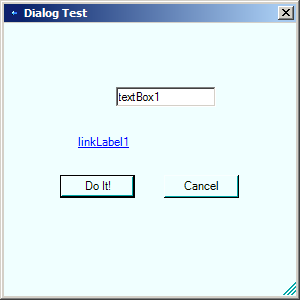Set DialogResult in your own dialog class : Dialog « GUI Windows Forms « C# / CSharp Tutorial
- C# / CSharp Tutorial
- GUI Windows Forms
- Dialog

using System;
using System.Drawing;
using System.Collections;
using System.ComponentModel;
using System.Windows.Forms;
using System.Data;
using System.Resources;
public class DialogCustomDialogResult : System.Windows.Forms.Form
{
private System.Windows.Forms.Button btnCreate;
private System.Windows.Forms.Label lblReturn;
public DialogCustomDialogResult()
{
InitializeComponent();
}
private void InitializeComponent()
{
this.btnCreate = new System.Windows.Forms.Button();
this.lblReturn = new System.Windows.Forms.Label();
this.SuspendLayout();
//
// btnCreate
//
this.btnCreate.Location = new System.Drawing.Point(80, 120);
this.btnCreate.Name = "btnCreate";
this.btnCreate.Size = new System.Drawing.Size(104, 23);
this.btnCreate.TabIndex = 1;
this.btnCreate.Text = "Create Dialog Box";
this.btnCreate.Click += new System.EventHandler(this.btnCreate_Click);
//
// lblReturn
//
this.lblReturn.Location = new System.Drawing.Point(64, 72);
this.lblReturn.Name = "lblReturn";
this.lblReturn.Size = new System.Drawing.Size(144, 23);
this.lblReturn.TabIndex = 2;
//
// DialogCustomDialogResult
//
this.AutoScaleBaseSize = new System.Drawing.Size(5, 13);
this.ClientSize = new System.Drawing.Size(292, 273);
this.Controls.AddRange(new System.Windows.Forms.Control[] {
this.lblReturn,
this.btnCreate});
this.ResumeLayout(false);
}
[STAThread]
static void Main()
{
Application.Run(new DialogCustomDialogResult());
}
private void btnCreate_Click(object sender, System.EventArgs e)
{
Form dlg = new MyDialog();
dlg.Text = "Dialog Test";
dlg.FormBorderStyle = FormBorderStyle.FixedDialog;
dlg.FormBorderStyle = FormBorderStyle.Sizable;
dlg.BackColor = Color.Azure;
dlg.ControlBox = true;
dlg.MaximizeBox = false;
dlg.MinimizeBox = false;
dlg.ShowInTaskbar = false;
dlg.Icon = new Icon("1.ICO");
dlg.Size = new Size(300,300);
dlg.StartPosition = FormStartPosition.CenterScreen;
dlg.ShowDialog();
lblReturn.Text = dlg.DialogResult.ToString();
switch (dlg.ShowDialog())
{
case DialogResult.Abort:
lblReturn.Text = "Abort, Abort";
break;
case DialogResult.Cancel:
lblReturn.Text = "You have cancelled.";
break;
case DialogResult.OK:
lblReturn.Text = "I'm OK, You're OK";
break;
default:
lblReturn.Text = "Whatever...";
break;
}
}
}
public class MyDialog : System.Windows.Forms.Form
{
private System.Windows.Forms.Button btnOK;
private System.Windows.Forms.Button btnCancel;
private System.Windows.Forms.TextBox textBox1;
private System.Windows.Forms.LinkLabel linkLabel1;
public MyDialog()
{
InitializeComponent();
}
private void InitializeComponent()
{
this.btnOK = new System.Windows.Forms.Button();
this.btnCancel = new System.Windows.Forms.Button();
this.textBox1 = new System.Windows.Forms.TextBox();
this.linkLabel1 = new System.Windows.Forms.LinkLabel();
this.SuspendLayout();
//
// btnOK
//
this.btnOK.DialogResult = System.Windows.Forms.DialogResult.OK;
this.btnOK.Location = new System.Drawing.Point(56, 152);
this.btnOK.Name = "btnOK";
this.btnOK.TabIndex = 0;
this.btnOK.Text = "Do It!";
//
// btnCancel
//
this.btnCancel.DialogResult = System.Windows.Forms.DialogResult.Cancel;
this.btnCancel.Location = new System.Drawing.Point(160, 152);
this.btnCancel.Name = "btnCancel";
this.btnCancel.TabIndex = 1;
this.btnCancel.Text = "Cancel";
//
// textBox1
//
this.textBox1.Location = new System.Drawing.Point(112, 64);
this.textBox1.Name = "textBox1";
this.textBox1.TabIndex = 2;
this.textBox1.Text = "textBox1";
//
// linkLabel1
//
this.linkLabel1.Location = new System.Drawing.Point(72, 112);
this.linkLabel1.Name = "linkLabel1";
this.linkLabel1.TabIndex = 3;
this.linkLabel1.TabStop = true;
this.linkLabel1.Text = "linkLabel1";
//
// MyDialog
//
this.AcceptButton = this.btnOK;
this.AutoScaleBaseSize = new System.Drawing.Size(5, 13);
this.ClientSize = new System.Drawing.Size(292, 273);
this.Controls.AddRange(new System.Windows.Forms.Control[] {
this.linkLabel1,
this.textBox1,
this.btnCancel,
this.btnOK});
this.Name = "MyDialog";
this.Text = "dlg";
this.ResumeLayout(false);
}
private void btnOK_Click(object sender, System.EventArgs e)
{
DialogResult = DialogResult.OK;
}
private void btnCancel_Click(object sender, System.EventArgs e)
{
DialogResult = DialogResult.Cancel;
}
}